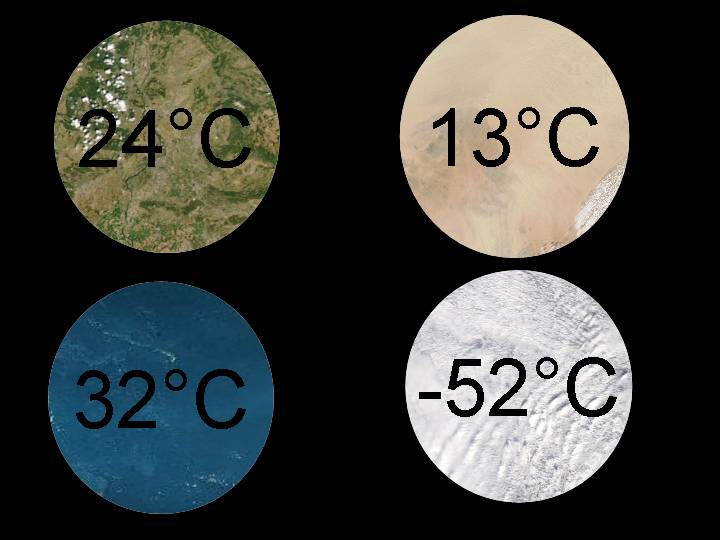|
|
 |
|
|
|
 |
| |
|
|
 |
Clouds & Particles
Basics |
Albedo
Albedo is a Latin word which means whiteness. We use it to describe how bright something is. To understand our global climate, we need to determine the albedo of the Earth.
|
|
|
|
|
 |
Colours
White light or light from the Sun is made up of several different colours. However, we only see these colours separately when we shine the white light through a prism or when a rainbow occurs. When light hits an object, three things can happen: the light can be reflected, transmitted or absorbed.
A mirror reflects back all the light arriving on it. Transparent objects (like water or glass) transmit light through them.
As light is made up several colours, one part can be reflected, another part can be absorbed. If all the colours are reflected, the object looks white to our eyes. If all of the colours are absorbed, the object is dark. If an object absorbs all the colours except - let's say - the red colour, our eyes see the red colour and we say the object is red.
The light which is absorbed is converted to heat. This is why, in summer, dark objects are warmer than bright ones as they absorb all the colours.
|
|
|
 |
1. Something is coloured because of the light it reflects back to your eyes. All the other colours of the spectrum are absorbed by the object.
Author: J. Gourdeau. |
The definition of albedo
The albedo is the ratio of the light reflected by an object to the total amount of light it receives. The albedo of an object ranges from 0 (no light reflected) to 1 (all light reflected). The albedo can also be expressed as a percentage.
|
The albedo of the Earth
The average albedo of our planet is around 0.3. This means that 30% of the sunlight that strikes the Earth is re-emitted back into space. Look at the Table to see the albedo (in %) of different surfaces. Rainforests have the lowest albedo on the Earth.
|
 |
Percentage albedo for
different types of surface
|
Fresh snow |
80-85 |
|
Old snow |
50-60 |
|
Grass |
20-25 |
|
Forest |
5-10 |
|
White paint |
80 |
|
Black paint |
5 | |
The mean temperature of the Earth's surface is 15 oC at present. If our planet was completely covered by forests (Ewok Planet) the average temperature would be 24 oC. If the Earth's surface was all desert (Planet Dune), the mean temperature would be 13 oC. If there were only oceans, the temperature would be 32 oC because water is dark and has a low albedo. If our planet was completely covered by ice, the temperature would be really cold, just -52 oC!
|
 |
 |
 |
|
2. Mean predicted surface temperatures if the Earth was covered by different surfaces with differing albedos.
|
|
The albedo of clouds
The albedo of the Earth depends on whether there are clouds in the sky. Clouds reflect more sunlight back into space than blue sky does. The albedo of a cloud depends on many factors including: the height of the cloud, its size and the number of water droplets inside the cloud. The colour of a cloud, from bright white to dark grey, depends on the water droplets in the cloud. Big droplets have a large surface area and reflect more light than small droplets. The presence of large numbers of water droplets leads to bright white clouds.
If you are under a big cumulonimbus cloud it's dark because the sunlight can't pass easily through the clouds. From space, however, the same cloud would look bright white because it actually has a high albedo. In contrast, a cirrus cloud is nearly transparent to sunlight but looks grey from space because it has a low albedo.
Imagine you are in the Space Shuttle admiring the Earth, the different cloud types you see all have different albedos and so reflect different amounts of light back into space.
|
 |
 |
|
3. Albedos of different clouds. Author: J. Gourdeau.
|
 |
 |
|
4. Visible satellite image over Europe in November, 2003. © 2003 EUMETSAT.
|
|
 |
The European satellite METEOSAT measures the amount of sunlight reflected by the clouds and the surface of the Earth. Water absorbs a lot of the sunlight which falls on it, so the oceans appear dark. Thick clouds have high albedos and show up brightly on the satellite image. Thin cirrus clouds have low albedos and are usually semi-transparent to sunlight. |
|
As a cloud usually has a higher albedo than the surface beneath it, the cloud reflects more radiation back to space than the surface would do in the absence of the cloud. So if clouds are present in the sky, less solar energy can get to the surface of the Earth. This reduces the amount of sunlight available to heat the surface and the air below the clouds.
This is one link between clouds and climate. But there is another way clouds affect our climate and we look at this on the next page!
|
|
About this page...
author: Dr. Justine Gourdeau - LaMP, Clermont-Ferrand, France
scientific reviewer: Dr. Maud Leriche - CNRS LaMP, Clermont-Ferrand, France
last published: 2004-05-06
|
|
 |
|







